A Bibliometric Analysis of Stroke Caregiver Research from 1989 to 2022
Abstract
:1. Introduction
2. Materials and Methods
2.1. Study Design, Search Terms and Study Flow
2.2. Statistical Analysis
2.3. Ethical Considerations
3. Results
3.1. General Information
3.2. Influential Articles
3.3. Language
3.4. Authors
3.5. Author’s Keyword and WOS’s Keywords-Plus
3.6. Journals
3.7. Institutions
3.8. Countries
4. Discussion
Strength and Limitations
5. Conclusions
Supplementary Materials
Author Contributions
Funding
Institutional Review Board Statement
Informed Consent Statement
Data Availability Statement
Acknowledgments
Conflicts of Interest
References
- Saini, V.; Guada, L.; Yavagal, D.R. Global Epidemiology of Stroke and Access to Acute Ischemic Stroke Interventions. Neurology 2021, 97, S6–S16. [Google Scholar] [CrossRef] [PubMed]
- Kuriakose, D.; Xiao, Z. Pathophysiology and Treatment of Stroke: Present Status and Future Perspectives. Int. J. Mol. Sci. 2020, 21, 7609. [Google Scholar] [CrossRef] [PubMed]
- Mei, Y.-X.; Lin, B.; Zhang, W.; Yang, D.-B.; Wang, S.-S.; Zhang, Z.-X.; Cheung, D.S.K. Benefits Finding among Chinese Family Caregivers of Stroke Survivors: A Qualitative Descriptive Study. BMJ Open 2020, 10, e038344. [Google Scholar] [CrossRef] [PubMed]
- Gawulayo, S.; Erasmus, C.J.; Rhoda, A.J. Family Functioning and Stroke: Family Members’ Perspectives. Afr. J. Disabil. 2021, 10, 801. [Google Scholar] [CrossRef] [PubMed]
- Mou, H.; Wong, M.S.; Chien, W.T. Effectiveness of Dyadic Psychoeducational Intervention for Stroke Survivors and Family Caregivers on Functional and Psychosocial Health: A Systematic Review and Meta-Analysis. Int. J. Nurs. Stud. 2021, 120, 103969. [Google Scholar] [CrossRef]
- Pucciarelli, G.; Ausili, D.; Galbussera, A.A.; Rebora, P.; Savini, S.; Simeone, S.; Alvaro, R.; Vellone, E. Quality of Life, Anxiety, Depression and Burden among Stroke Caregivers: A Longitudinal, Observational Multicentre Study. J. Adv. Nurs. 2018, 74, 1875–1887. [Google Scholar] [CrossRef]
- Gertrude, N.; Kawuma, R.; Nalukenge, W.; Kamacooko, O.; Yperzeele, L.; Cras, P.; Ddumba, E.; Newton, R.; Seeley, J. Caring for a Stroke Patient: The Burden and Experiences of Primary Caregivers in Uganda—A Qualitative Study. Nurs. Open 2019, 6, 1551–1558. [Google Scholar] [CrossRef] [Green Version]
- Bakas, T.; McCarthy, M.; Miller, E.T. Update on the State of the Evidence for Stroke Family Caregiver and Dyad Interventions. Stroke 2017, 48, e122–e125. [Google Scholar] [CrossRef] [Green Version]
- Aria, M.; Cuccurullo, C. Bibliometrix: An R-Tool for Comprehensive Science Mapping Analysis. J. Informetr. 2017, 11, 959–975. [Google Scholar] [CrossRef]
- Donthu, N.; Kumar, S.; Mukherjee, D.; Pandey, N.; Lim, W.M. How to Conduct a Bibliometric Analysis: An Overview and Guidelines. J. Bus. Res. 2021, 133, 285–296. [Google Scholar] [CrossRef]
- Zupic, I.; Čater, T. Bibliometric Methods in Management and Organization. Organ. Res. Methods 2015, 18, 429–472. [Google Scholar] [CrossRef]
- Brandt, J.S.; Hadaya, O.; Schuster, M.; Rosen, T.; Sauer, M.V.; Ananth, C.V. A Bibliometric Analysis of Top-Cited Journal Articles in Obstetrics and Gynecology. JAMA Netw. Open 2019, 2, e1918007. [Google Scholar] [CrossRef] [PubMed]
- Ma, W.; Li, X.; Yang, Y.-B.; Zhai, Y.; Xie, T.-T.; Gong, Z.-Y.; Lan, B.; Liu, J.; Mo, X.-N. Bibliometric Analysis of Global Research Trends in Post-Stroke Depression: Hotspots and Frontiers. Front. Public Health 2023. [Google Scholar] [CrossRef]
- Dong, J.; Wei, W.; Wang, C.; Fu, Y.; Li, Y.; Li, J.; Peng, X. Research Trends and Hotspots in Caregiver Studies: A Bibliometric and Scientometric Analysis of Nursing Journals. J. Adv. Nurs. 2020, 76, 2955–2970. [Google Scholar] [CrossRef] [PubMed]
- Nash-Stewart, C.E.; Kruesi, L.M.; Del Mar, C.B. Does Bradford’s Law of Scattering Predict the Size of the Literature in Cochrane Reviews? J. Med. Libr. Assoc. 2012, 100, 135–138. [Google Scholar] [CrossRef] [Green Version]
- R Core Team. R: A Language and Environment for Statistical Computing; R Foundation for Statistical Computing: Vienna, Austria, 2022. [Google Scholar]
- RStudio Team. RStudio: Integrated Development Environment for R; RStudio: Boston, MA, USA, 2022. [Google Scholar]
- Wickham, H. Tidyverse: Easily Install and Load the Tidyverse; RStudio: Boston, MA, USA, 2021. [Google Scholar]
- McCullagh, E.; Brigstocke, G.; Donaldson, N.; Kalra, L. Determinants Of Caregiving Burden and Quality of Life in Caregivers of Stroke Patients. Stroke 2005, 36, 2181–2186. [Google Scholar] [CrossRef] [Green Version]
- Jönsson, A.C.; Lindgren, I.; Hallström, B.; Norrving, B.; Lindgren, A. Determinants Of Quality of Life in Stroke Survivors and Their Informal Caregivers. Stroke 2005, 36, 803–808. [Google Scholar] [CrossRef] [Green Version]
- Elmståhl, S.; Malmberg, B.; Annerstedt, L. Caregiver’s Burden of Patients 3 Years After Stroke Assessed by A Novel Caregiver Burden Scale. Arch. Phys. Med. Rehabil. 1996, 77, 177–182. [Google Scholar] [CrossRef]
- Grant, J.S.; Elliott, T.R.; Weaver, M.; Bartolucci, A.A.; Giger, J.N. Telephone Intervention with Family Caregivers of Stroke Survivors After Rehabilitation. Stroke 2002, 33, 2060–2065. [Google Scholar] [CrossRef] [Green Version]
- Rigby, H.; Gubitz, G.; Phillips, S. A Systematic Review of Caregiver Burden Following Stroke. Int. J. Stroke 2009, 4, 285–292. [Google Scholar] [CrossRef]
- Pollock, A.; St George, B.; Fenton, M.; Firkins, L. Top 10 Research Priorities Relating to Life After Stroke-Consensus from Stroke Survivors, Caregivers, and Health Professionals. Int. J. Stroke 2014, 9, 313–320. [Google Scholar] [CrossRef] [PubMed]
- Bugge, C.; Alexander, H.; Hagen, S. Stroke Patients’ Informal Caregivers-Patient, Caregiver, and Service Factors That Affect Caregiver Strain. Stroke 1999, 30, 1517–1523. [Google Scholar] [CrossRef] [PubMed] [Green Version]
- Morimoto, T.; Schreiner, A.S.; Asano, H. Caregiver Burden and Health-Related Quality of Life Among Japanese Stroke Caregivers. Age Ageing 2003, 32, 218–223. [Google Scholar] [CrossRef] [PubMed] [Green Version]
- Draper, B.M.; Poulos, C.J.; Cole, A.M.; Poulos, R.G.; Ehrlich, F. A Comparison of Caregivers for Elderly Stroke and Dementia Victims. J. Am. Geriatr. Soc. 1992, 40, 896–901. [Google Scholar] [CrossRef] [PubMed]
- Cameron, J.I.; Gignac, M.A. “Timing It Right”: A Conceptual Framework for Addressing the Support Needs of Family Caregivers to Stroke Survivors From The Hospital To The Home. Patient Educ. Couns. 2008, 70, 305–314. [Google Scholar] [CrossRef]
- Loh, A.Z.; Tan, J.S.; Zhang, M.W.; Ho, R.C. The Global Prevalence of Anxiety and Depressive Symptoms Among Caregivers of Stroke Survivors. J. Am. Med. Dir. Assoc. 2017, 18, 111–116. [Google Scholar] [CrossRef]
- Pindus, D.M.; Mullis, R.; Lim, L.; Wellwood, I.; Rundell, A.V.; Abd Aziz, N.A.; Mant, J. Stroke Survivors’ and Informal Caregivers’ Experiences of Primary Care and Community Healthcare Services-A Systematic Review and Meta Ethnography. PLoS ONE 2018, 13, e0192533. [Google Scholar]
- Bakas, T.; Clark, P.C.; Kelly-Hayes, M.; King, R.B.; Lutz, B.J.; Miller, E.L. Evidence For Stroke Family Caregiver and Dyad Interventions A Statement for Healthcare Professionals from The American Heart Association and American Stroke Association. Stroke 2014, 45, 2836–2852. [Google Scholar] [CrossRef] [Green Version]
- Zorowitz, R.D.; Gillard, P.J.; Brainin, M. Poststroke Spasticity Sequelae and Burden on Stroke Survivors and Caregivers. Neurology 2013, 80, S45–S52. [Google Scholar] [CrossRef]
- Forster, A.; Dickerson, J.; Young, J.; Patel, A.; Kalra, L.; Nixon, J.; Smithard, D.; Knapp, M.; Holloway, I.; Anwar, S.; et al. A Structured Training Programme for Caregivers of Inpatients After Stroke (TRACS): A Cluster Randomised Controlled Trial and Cost-Effectiveness Analysis. Lancet 2013, 382, 2069–2076. [Google Scholar] [CrossRef] [Green Version]
- Qiu, X.; Sit, J.W.H.; Koo, F.K. The influence of Chinese culture on family caregivers of stroke survivors: A qualitative study. J. Clin. Nurs. 2018, 27, e309–e319. [Google Scholar] [CrossRef] [Green Version]
- Lund, M. Caregiver, Take Care. Geriatr. Nurs. 2005, 26, 152–153. [Google Scholar] [CrossRef]
- Bakas, T.; McCarthy, M.J.; Miller, E.L. Systematic Review of the Evidence for Stroke Family Caregiver and Dyad Interventions. Stroke 2022, 53, 2093–2102. [Google Scholar] [CrossRef] [PubMed]
- Kum, C.; Miller, E.L.; Jones, H.; Kean, E.B.; Kreitzer, N.; Bakas, T. Theoretically Based Factors Affecting Stroke Family Caregiver Health: An Integrative Review. West. J. Nurs. Res. 2022, 44, 338–351. [Google Scholar] [CrossRef] [PubMed]
- Kamadjeu, R. English: The Lingua Franca of Scientific Research. Lancet Glob. Health 2019, 7, e1174. [Google Scholar] [CrossRef] [PubMed] [Green Version]
- London, B. Reviewing Peer Review. J. Am. Heart Assoc. 2021, 10, e021475. [Google Scholar] [CrossRef] [PubMed]
- Likis, F.E. Where Should You Publish? Choosing a Journal for Your Manuscript. J. Midwifery Womens Health 2018, 63, 7–9. [Google Scholar] [CrossRef] [PubMed] [Green Version]
- Bavdekar, S.B.; Save, S. Choosing the Right Journal for a Scientific Paper. J. Assoc. Physicians India 2015, 63, 56–58. [Google Scholar]
- Katan, M.; Luft, A. Global Burden of Stroke. Semin. Neurol. 2018, 38, 208–211. [Google Scholar] [CrossRef] [Green Version]
- Feigin, V.L.; Stark, B.A.; Johnson, C.O. GBD 2019 Stroke Collaborators Global, Regional, and National Burden of Stroke and Its Risk Factors, 1990–2019: A Systematic Analysis for the Global Burden of Disease Study 2019. Lancet Neurol. 2021, 20, 795–820. [Google Scholar] [CrossRef]
- Pandian, J.D.; William, A.G.; Kate, M.P.; Norrving, B.; Mensah, G.A.; Davis, S.; Roth, G.A.; Thrift, A.G.; Kengne, A.P.; Kissela, B.M.; et al. Strategies to Improve Stroke Care Services in Low- and Middle-Income Countries: A Systematic Review. Neuroepidemiology 2017, 49, 45–61. [Google Scholar] [CrossRef] [PubMed]
- Yan, L.L.; Li, C.; Chen, J.; Miranda, J.J.; Luo, R.; Bettger, J.; Zhu, Y.; Feigin, V.; O’Donnell, M.; Zhao, D.; et al. Prevention, Management, and Rehabilitation of Stroke in Low- and Middle-Income Countries. eNeurologicalSci 2016, 2, 21–30. [Google Scholar] [CrossRef]
- Githaiga, J.N. Culture, Role Conflict and Caregiver Stress: The Lived Experiences of Family Cancer Caregivers in Nairobi. J. Health Psychol. 2017, 22, 1591–1602. [Google Scholar] [CrossRef] [PubMed]
- Tseung, V.; Jaglal, S.B.; Salbach, N.M.; Cameron, J.I. Implementing Caregiver Support Programs in a Regional Stroke System. Stroke 2019, 50, 3585–3591. [Google Scholar] [CrossRef] [PubMed]
- Belter, C.W. Bibliometric Indicators: Opportunities and Limits. J. Med. Libr. Assoc. 2015, 103, 219–221. [Google Scholar] [CrossRef] [Green Version]
- Zhu, J.; Liu, W. A Tale of Two Databases: The Use of Web of Science and Scopus in Academic Papers. Scientometrics 2020, 123, 321–335. [Google Scholar] [CrossRef] [Green Version]
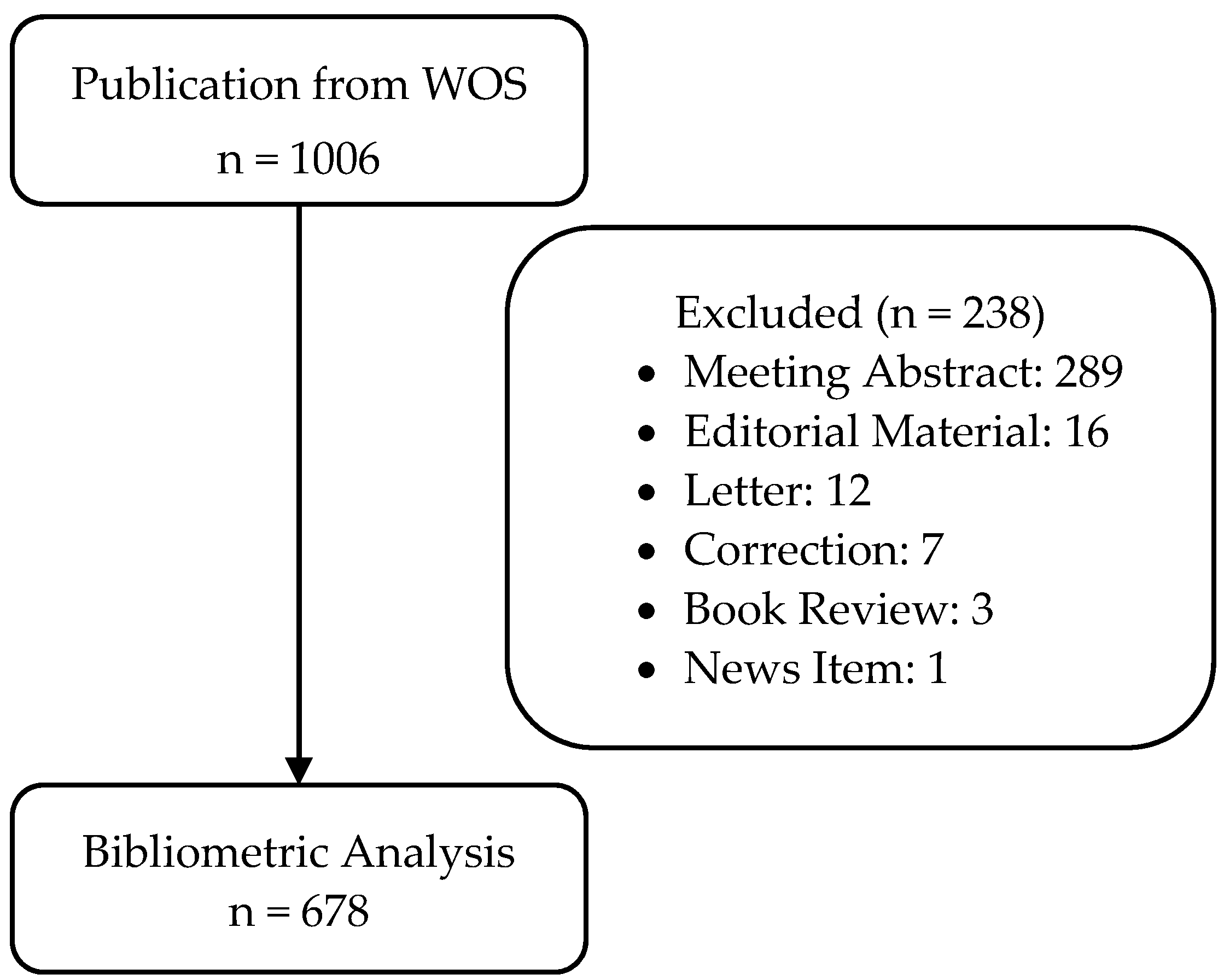
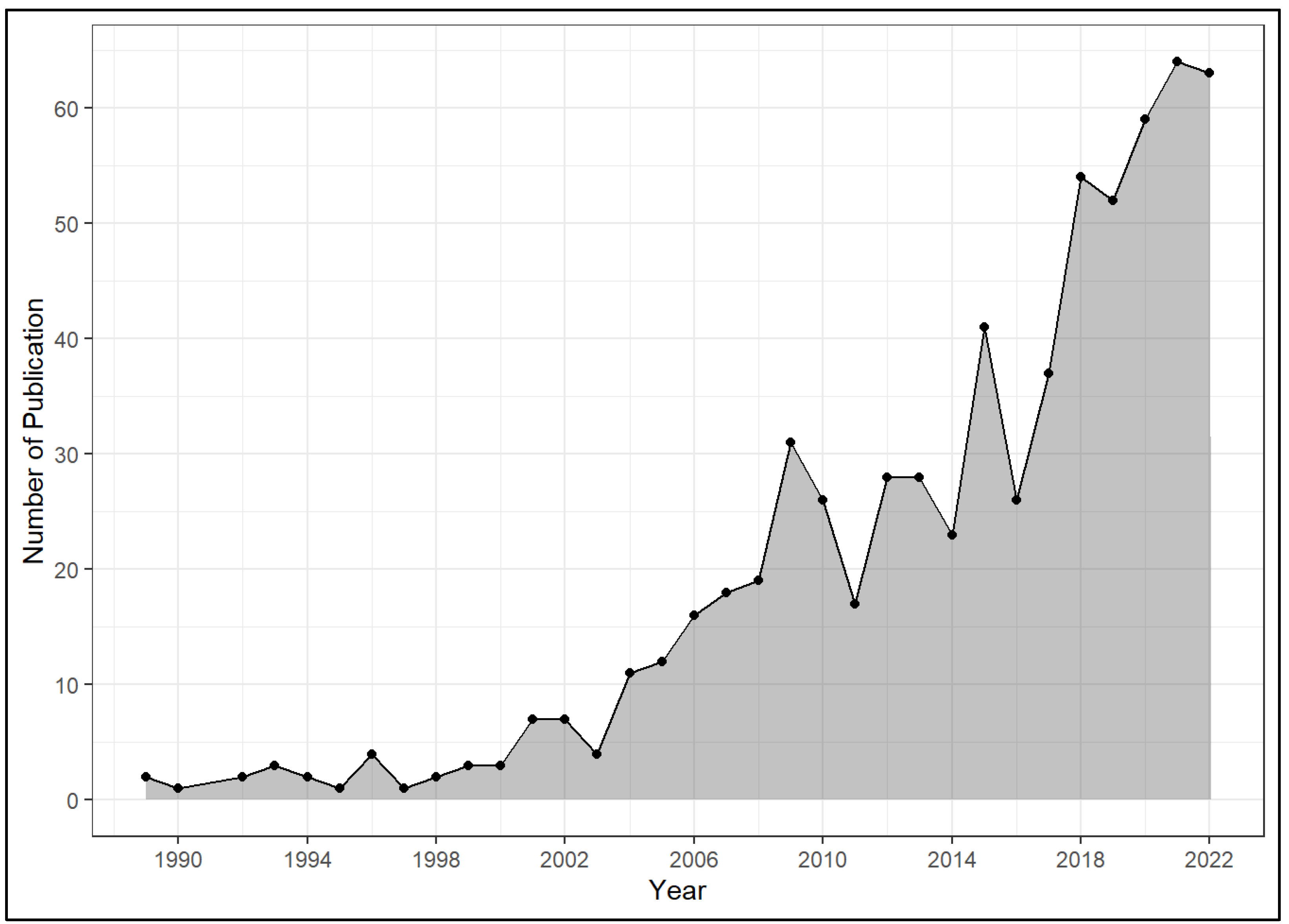
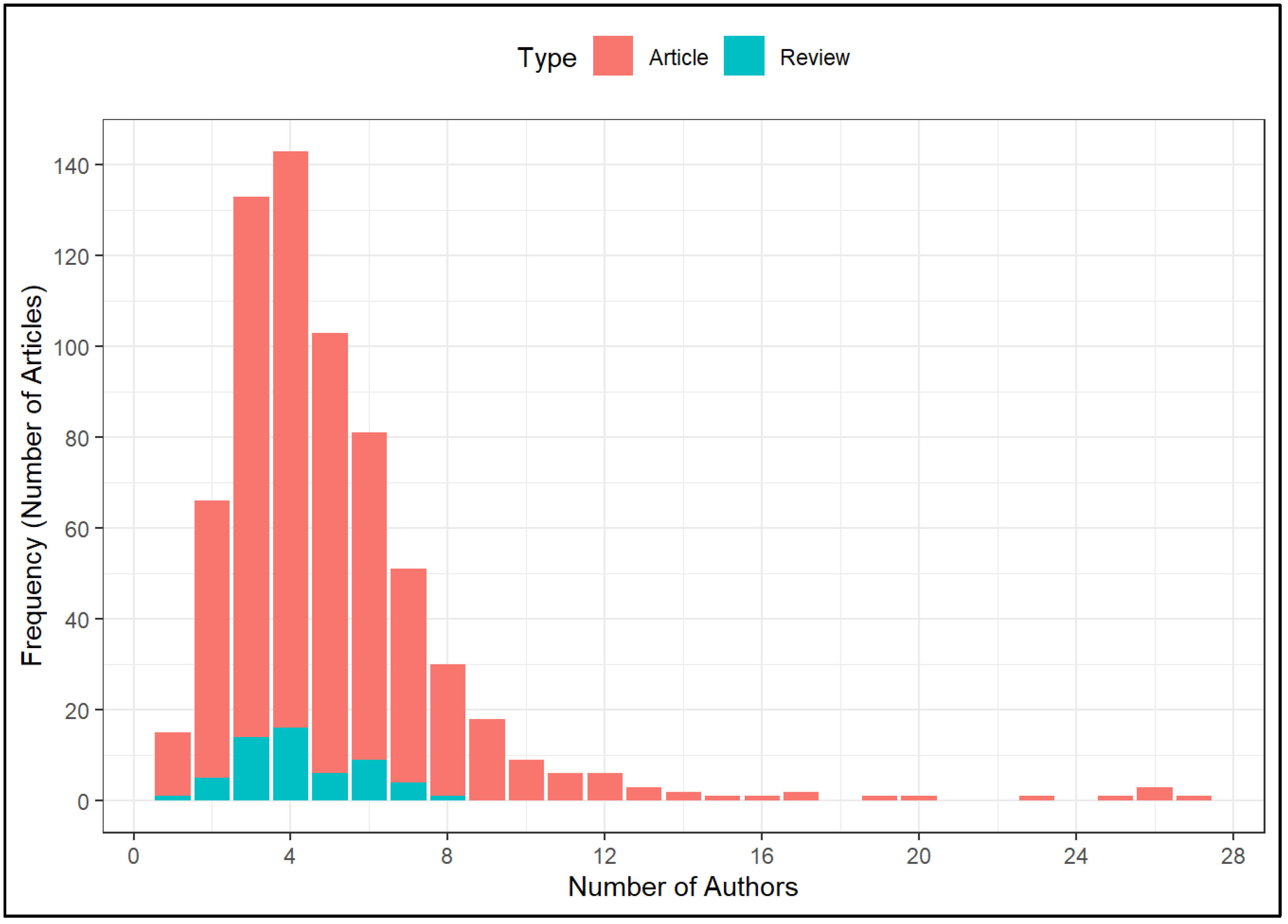


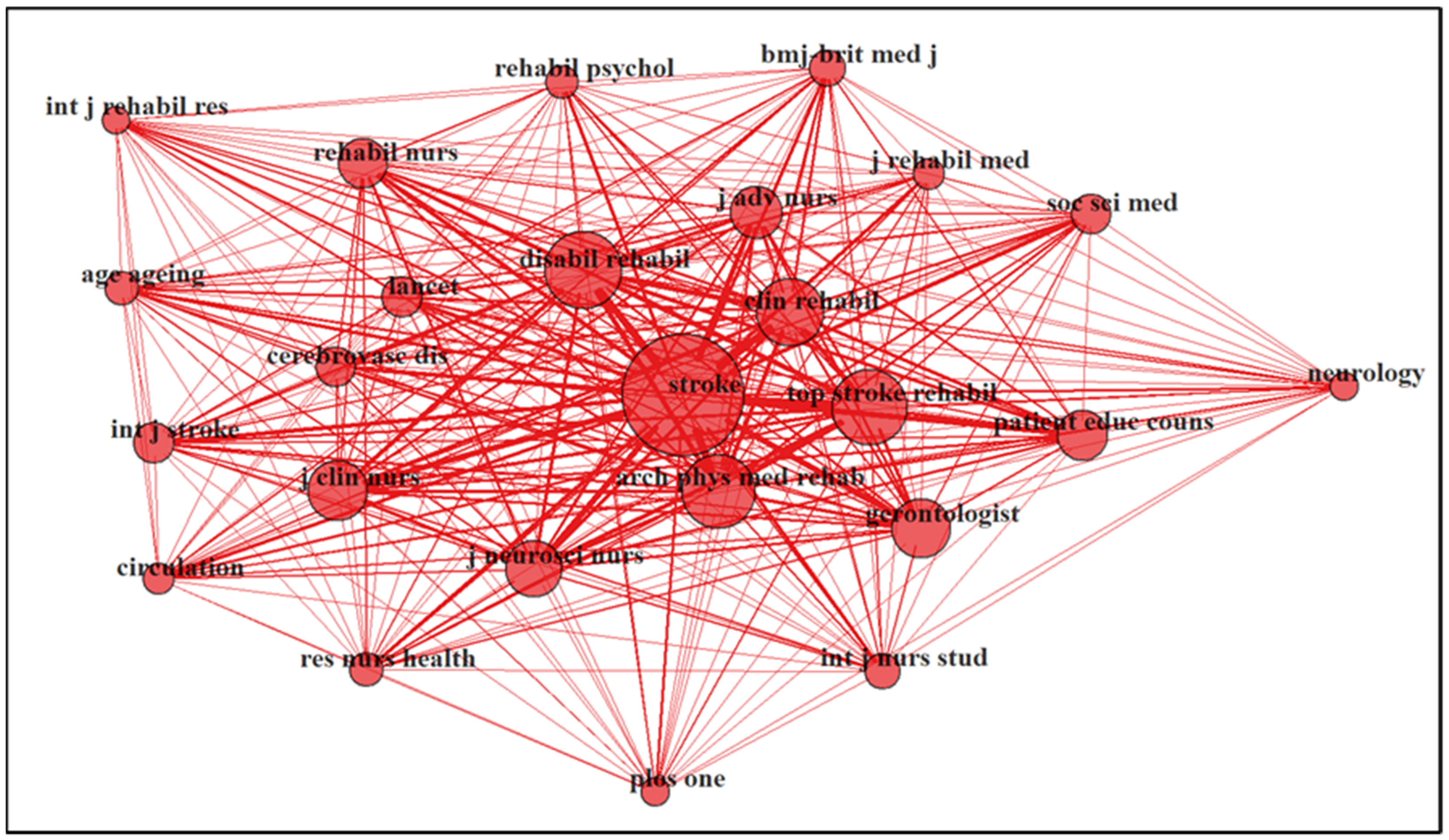

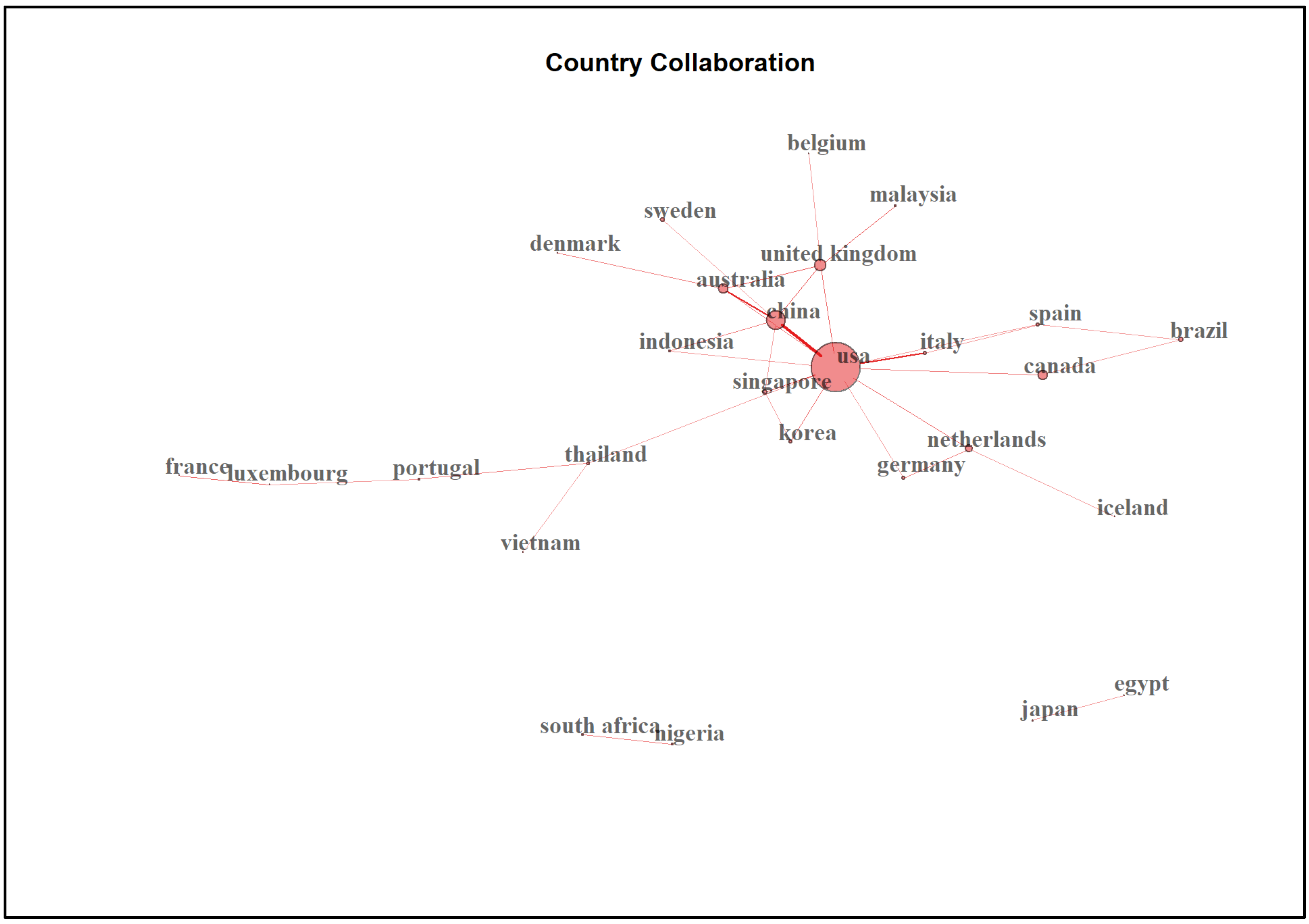
| Rank | Title | Author, Year | Number of Citations | Average Number of Citations per Year |
|---|---|---|---|---|
| 1 | Determinants Of Caregiving Burden and Quality of Life in Caregivers of Stroke Patients | McCullagh et al., 2005 [19] | 277 | 15.39 |
| 2 | Determinants Of Quality of Life in Stroke Survivors and Their Informal Caregivers | Jönsson et al., 2005 [20] | 220 | 12.22 |
| 3 | Caregiver’s Burden of Patients 3 Years After Stroke Assessed by A Novel Caregiver Burden Scale | Elmståhl, Malmberg and Annerstedt, 1996 [21] | 209 | 7.74 |
| 4 | Telephone Intervention with Family Caregivers of Stroke Survivors After Rehabilitation | Grant et al., 2002 [22] | 204 | 9.71 |
| 5 | A Systematic Review of Caregiver Burden Following Stroke | Rigby, Gubitz and Phillips, 2009 [23] | 192 | 13.71 |
| 6 | Top 10 Research Priorities Relating to Life After Stroke-Consensus from Stroke Survivors, Caregivers, and Health Professionals | Pollock et al., 2014 [24] | 190 | 21.11 |
| 7 | Stroke Patients’ Informal Caregivers-Patient, Caregiver, and Service Factors That Affect Caregiver Strain | Bugge, Alexander and Hagen, 1999 [25] | 183 | 7.63 |
| 8 | Caregiver Burden and Health-Related Quality of Life Among Japanese Stroke Caregivers | Morimoto, Schreiner and Asano, 2003 [26] | 180 | 9.00 |
| 9 | A Comparison of Caregivers for Elderly Stroke and Dementia Victims | Draper et al., 1992 [27] | 177 | 5.71 |
| 10 | “Timing It Right”: A Conceptual Framework for Addressing the Support Needs of Family Caregivers to Stroke Survivors From The Hospital To The Home | Cameron and Gignac, 2008 [28] | 170 | 11.33 |
| Rank | Title | Author, Year | Number of Citations | Average Number of Citations per Year |
|---|---|---|---|---|
| 1 | The Global Prevalence of Anxiety and Depressive Symptoms Among Caregivers of Stroke Survivors | Loh et al., 2017 [29] | 131 | 21.83 |
| 2 | Top 10 Research Priorities Relating to Life After Stroke-Consensus from Stroke Survivors, Caregivers, Additionally, Health Professionals | Pollock et al., 2014 [24] | 190 | 21.11 |
| 3 | Stroke Survivors’ and Informal Caregivers’ Experiences of Primary Care and Community Healthcare Services-A Systematic Review and Meta Ethnography | Pindus et al., 2018 [30] | 82 | 16.40 |
| 4 | Evidence For Stroke Family Caregiver and Dyad Interventions A Statement for Healthcare Professionals from The American Heart Association and American Stroke Association | Bakas et al., 2014 [31] | 143 | 15.89 |
| 5 | Determinants Of Caregiving Burden and Quality of Life in Caregivers of Stroke Patients | McCullagh et al., 2005 [19] | 277 | 15.39 |
| 6 | Poststroke Spasticity Sequelae and Burden on Stroke Survivors and Caregivers | Zorowitz, Gillard and Brainin, 2013 [32] | 140 | 14.00 |
| 7 | A Systematic Review of Caregiver Burden Following Stroke | Rigby, Gubitz and Phillips, 2009 [23] | 192 | 13.71 |
| 8 | A Structured Training Programme for Caregivers of Inpatients After Stroke (TRACS): A Cluster Randomised Controlled Trial and Cost-Effectiveness Analysis | Forster et al., 2013 [33] | 85 | 12.64 |
| 9 | The influence of Chinese culture on family caregivers of stroke survivors: A qualitative study | Qiu, Sit and Koo, 2018 [34] | 60 | 12.60 |
| 10 | Determinants Of Quality of Life in Stroke Survivors and Their Informal Caregivers | Jönsson et al., 2005 [20] | 220 | 12.22 |
| Rank | Author Name | Number of Publications, n (%) |
|---|---|---|
| 1 | Tamilyn Bakas | 21 (3.1) |
| 2 | Joan S. Grant | 15 (2.2) |
| 3 | Barbara J Lutz | 13 (1.9) |
| =4 | David L Roth | 12 (1.8) |
| =4 | Ercole Vellone | 12 (1.8) |
| =6 | William E Haley | 11 (1.6) |
| =6 | Gerald C H Koh | 11 (1.6) |
| =6 | Gianluca Pucciarelli | 11 (1.6) |
| =9 | Rosario Alvaro | 10 (1.5) |
| =9 | Jill I Cameron | 10 (1.5) |
| =9 | Amy Forster | 10 (1.5) |
| =9 | Linda L Pierce | 10 (1.5) |
| =9 | Victoria Steiner | 10 (1.5) |
| Rank | Author’s Keyword | Publications, n (%) | WOS’s Keyword-Plus | Publications, n (%) |
|---|---|---|---|---|
| 1 | Stroke | 453 (66.8) | Survivors | 181 (26.6) |
| 2 | Caregivers | 198 (29.2) | Burden | 179 (26.4) |
| 3 | Caregiver | 118 (17.4) | Quality-of-life | 149 (21.9) |
| 4 | Depression | 82 (12.0) | Family caregivers | 137 (20.2) |
| 5 | Quality Of Life | 73 (10.7) | Care | 136 (20.0) |
| 6 | Rehabilitation | 70 (10.3) | Health | 132 (19.4) |
| 7 | Burden | 44 (6.4) | Impact | 114 (16.8) |
| 8 | Family Caregivers | 44 (6.4) | Rehabilitation | 88 (12.9) |
| 9 | Caregiver Burden | 38 (5.6) | Depression | 75 (11.0) |
| 10 | Anxiety | 30 (4.4) | Spouses | 75 (11.0) |
| Rank | Journal Name | Number of Publications, n (%) |
|---|---|---|
| 1 | Topics In Stroke Rehabilitation | 40 (5.8) |
| 2 | Stroke | 29 (4.2) |
| 3 | Rehabilitation Nursing | 21 (3.0) |
| 4 | Journal of Neuroscience Nursing | 20 (2.9) |
| 5 | Journal of Clinical Nursing | 18 (2.6) |
| 6 | Journal of Advanced Nursing | 17 (2.5) |
| 7 | Disability and Rehabilitation | 16 (2.3) |
| 8 | Rehabilitation Psychology | 15 (2.2) |
| 9 | BMJ Open | 14 (2.0) |
| 10 | Clinical Rehabilitation | 13 (1.9) |
| 11 | Archives of Physical Medicine and Rehabilitation | 11 (1.6) |
| 12 | Scandinavian Journal of Caring Sciences | 10 (1.4) |
| Rank | Institution | Number of Publications, n (%) |
|---|---|---|
| 1 | University of Toronto | 65 (9.5) |
| 2 | University of Florida | 60 (8.8) |
| 3 | The University of Alabama at Birmingham | 49 (7.2) |
| 4 | National University of Singapore | 38 (5.6) |
| 5 | The University of Texas Health Science Center at Houston | 36 (5.3) |
| 6 | University of Cincinnati | 34 (5.0) |
| 7 | Chinese University of Hong Kong | 31 (4.5) |
| 8 | Maastricht University | 26 (3.8) |
| =9 | Università degli studi di Roma Tor Vergata | 26 (3.8) |
| =9 | Zhengzhou University | 26 (3.8) |
| Highest Number of Publications | Highest Number of Total Citations | |||||
|---|---|---|---|---|---|---|
| Rank | Country | Number of Publications, n (%) | Rank | Country | Total Citations | Average Article Citations |
| 1 | USA | 193 (28.6) | 1 | USA | 4720 | 24.46 |
| 2 | China | 82 (12.1) | 2 | United Kingdom | 1472 | 50.76 |
| 3 | Canada | 41 (6.1) | 3 | Canada | 1455 | 35.49 |
| 4 | Netherlands | 33 (4.9) | 4 | China | 1240 | 15.12 |
| 5 | United Kingdom | 29 (4.3) | 5 | Netherlands | 1183 | 35.85 |
| 6 | Brazil | 24 (3.6) | 6 | Sweden | 737 | 49.13 |
| 7 | Australia | 23 (3.4) | 7 | Australia | 590 | 25.65 |
| 8 | Turkey | 21 (3.1) | 8 | Korea | 319 | 17.72 |
| =9 | Korea | 18 (2.7) | 9 | Italy | 289 | 19.27 |
| =9 | Singapore | 18 (2.7) | 10 | Denmark | 277 | 277.00 |
| World Bank Country Income Group | Number of Publication, n (%) | Total Citations | Average Article Citations |
|---|---|---|---|
| High Income | 462 (68.1) | 12,421 | 26.89 |
| Upper-Middle Income | 172 (25.4) | 1796 | 10.44 |
| Lower-Middle Income | 39 (5.6) | 354 | 9.08 |
| Low Income | 2 (0.3) | 11 | 5.50 |
Disclaimer/Publisher’s Note: The statements, opinions and data contained in all publications are solely those of the individual author(s) and contributor(s) and not of MDPI and/or the editor(s). MDPI and/or the editor(s) disclaim responsibility for any injury to people or property resulting from any ideas, methods, instructions or products referred to in the content. |
© 2023 by the authors. Licensee MDPI, Basel, Switzerland. This article is an open access article distributed under the terms and conditions of the Creative Commons Attribution (CC BY) license (https://creativecommons.org/licenses/by/4.0/).
Share and Cite
Bin Suliman, M.A.; Hanis, T.M.; Kamdi, M.K.A.; Ibrahim, M.I.; Musa, K.I. A Bibliometric Analysis of Stroke Caregiver Research from 1989 to 2022. Int. J. Environ. Res. Public Health 2023, 20, 4642. https://doi.org/10.3390/ijerph20054642
Bin Suliman MA, Hanis TM, Kamdi MKA, Ibrahim MI, Musa KI. A Bibliometric Analysis of Stroke Caregiver Research from 1989 to 2022. International Journal of Environmental Research and Public Health. 2023; 20(5):4642. https://doi.org/10.3390/ijerph20054642
Chicago/Turabian StyleBin Suliman, Mohd Azmi, Tengku Muhammad Hanis, Mohd Khairul Anwar Kamdi, Mohd Ismail Ibrahim, and Kamarul Imran Musa. 2023. "A Bibliometric Analysis of Stroke Caregiver Research from 1989 to 2022" International Journal of Environmental Research and Public Health 20, no. 5: 4642. https://doi.org/10.3390/ijerph20054642









